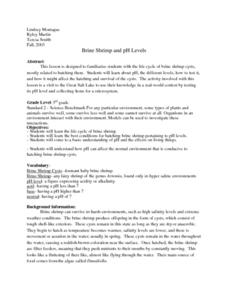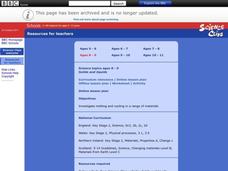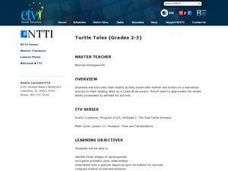Curated OER
Forces in Action
Students investigate different forces and draw arrows to signify specific directions of force. Students are then shown a brick and they are asked to draw a diagram which will include labels for the forces that are acting on the brick....
Curated OER
Forces and Movement
Students investigate the forces of pushing and pulling by participating in a whole group activity involving a toy car. Students then participate in a small group experiment involving a toy car, small weights and various materials....
Curated OER
Reversible and irreversible changes
Students define the words "reversible" and "irreversible." They complete a worksheet that shows a number of changes. Students must decide which are reversible and which are irreversible.
Curated OER
Pushes and Pulls
Students discuss and investigate how various vehicles move. In a small groups, students then create a wheeled vehicle and find a way to make it move using various resources provided by the teacher.
Curated OER
Brine Shrimp And Ph Levels
Third graders investigate the different ph levels found in water that is tested using simple measurements. The water samples are taken from a local body of water. The ph levels are used to help indicate areas where shrimp can thrive in...
Curated OER
Changing Circuits
Learners observe an on-line activity to review the basics of electrical circuitry, then research answers to related questions on-line.In this lesson on changing components in a series circuit, students discover how different components...
Curated OER
Solids and Liquids
Students investigate what happens to solids and liquids when they change from one form to another. In this states of matter lesson, students work in groups on a virtual experiment that requires them to collect data regarding the melting...
Curated OER
Moving and Growing
Young scholars learn to understand the role of both skeletons and exoskeletons. In this lesson plan on exoskeletons, students locate and label bones on diagram of a human skeleton, and observe and discuss bones of chicken and fish. Young...
Curated OER
Keeping Warm
Students investigate how different types of objects act as thermal insulators. In this online lesson plan, students hypothesize how particular objects act as insulators and then complete the online activity to determine which materials...
Curated OER
Pushes and Pulls
Students examine different types of movement and causes that may affect those movements. In this online interactive forces and motion lesson, students use toy cars to observe push and pull and then make predictions and collect data...
Curated OER
Gases Around Us
Students investigate gases and liquids. In this states of matter online lesson, students examine how evaporation plays a part in the transition of liquids into gases as they watch a kettle of water boil and then work in small groups on...
Curated OER
Micro-organisms
Learners discuss micro-organisms. In this micro-organisms lesson, students identify which micro-organisms are harmful and which ones are beneficial. Learners complete a worksheet which is included in the lesson.
Curated OER
Water and Ice
Students explore the physical properties of water. In this water lesson, students explore water as it changes states. They observe, measure and use communication skills to describe change.
Curated OER
Powerful Potato
Students are introduced to the growth process of a potato. As a class, they place a potato on a plate and observe how long it takes for the eyes to appear. In groups, they follow a recipe to make potato soup that is shared with the...
Curated OER
Plant Reproduction
In this plant reproduction instructional activity, students complete a crossword puzzle with 36 questions. They identify the different plant reproductive features.
Pennsylvania Department of Education
Pennsylvania’s Energy Supply
Third graders become familiar with the various types of energy and which types are found in Pennsylvania. In this Pennsylvanian energy resources lesson, 3rd graders, identify wind and water as sources of energy. Students...
Pennsylvania Department of Education
Wind and Water Wheels
Students identify wind and water as natural resources that create energy. In this natural resources and energy use lesson, students work in groups to construct a pinwheel, then explore the effects of wind and water on the pinwheel....
Curated OER
Sunflowers (Grades 3-8)
Students examine sunflowers and discuss the importance of sunflower cooking oil and seeds. They view pictures, read books, sing sunflower songs, and grow flowers from sunflower seeds.
Curated OER
Bird Feeding and Migration Observation
Students research bird migration and build a bird house. In this bird lesson plan, students research the birds in their area and where they migrate to. They also build their own bird house and record data on what kinds of birds come to...
Curated OER
Exploring Limu Diversity
Students explore limu diversity. In this ocean ecosystem lesson, students classify limu according to its physical properties. Students work in small groups to generate scientific observations and sort limu by characteristics.
Curated OER
Reasons for Seasons
Students investigate a model of the tilt of the Earth in its relationship to the Sun during the different seasons of the year. They study the solstices and equinoxes, while determining how sunlight hits the Earth with different angles in...
Curated OER
Turtle Tales
Students watch videos and fill out worksheets about the turtles and their journey to the Costa Rican beach. For this turtles lesson plan, students learn and discuss survival, predator and prey, and stages of development.
Curated OER
Thermal Pollution
In this pollution learning exercise, students read about thermal pollution and how hot water affects wildlife. Then students complete 1 short answer question.
Curated OER
The Global Impact of Insect Borne Diseases & Agriculture
Students study the global impact of insect borne diseases, the appropriate use of pesticides, and the concept of human interrelations on a world wide scale. They examine how to safely apply a pesticide, according to the label.

























